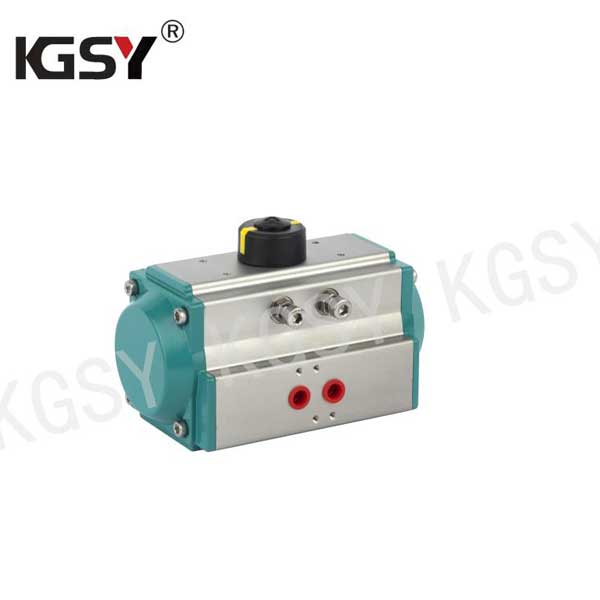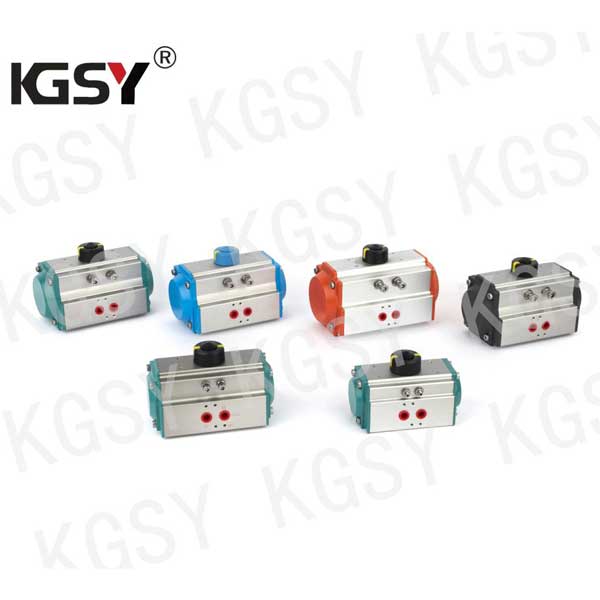When the gas shrinks from the A nozzle to the pneumatic actuator, the gas leads the double piston to both sides (the cylinder head end), the worm on the piston turns the gear on the drive shaft 90 degrees, and the shut-off valve opens. At this time, the air on both sides of the pneumatic actuator valve is discharged from the B nozzle.
Conversely, when the gas shrinks from the B nozzle to both sides of the pneumatic actuator, the gas moves the double plug straight to the middle, the worm on the piston turns the gear 90 degrees clockwise, and the shut-off valve is closed. At this time, the air in the middle of the pneumatic actuator is discharged from the A nozzle.
From a big perspective, it is divided into two internal structures: gear type and bifurcation type. The gear type is the net weight of the transmission, and the bifurcated type is the net weight of the transmission. Don't underestimate such a small difference. It's also part of a key upgrade! In this case, the electric actuator can be changed from the original immediate stroke arrangement to a reasonable stroke arrangement that is more in line with the perspective of the valve butterfly valve, the volume can be reduced to 2/3 of the past, and the gas circuit can be saved by about 30%
Pneumatic actuator structural features:
(1) The engine block of extruded aluminum alloy profile is solved by hard air oxidation, the surface material is hard and solid, and the wear resistance is strong.
(2) Tight double-piston gear. Worm structure, precise tooth engagement, stable transmission system, symmetry of installation parts, and stable output torque.
(3) The F4 guide ring is installed on the main moving position of the piston, worm and output shaft, to achieve low friction, long service life, and prevent metal materials from contacting each other.
(4) Engine block. Bearing end cover. Output shaft. Torsion spring. Standard parts, etc.
(5) The torsion spring of a single air-controlled electric actuator is installed after prestressing tension, which is safe and convenient to disassemble.
(6) The AT pneumatic actuator can adjust the double stroke arrangement of 0 degrees, 90 degrees, and 5 degrees of positive and negative poles at the opening and closing parts.
(7) The installation and connection specifications are in line with ISO5211.DIN337, VD1/VDE3845 and NUMAR specifications, and AT160 is guaranteed.
Vacuum solenoid valve, travel switch and other accessories are easy to install.
(8) There are various shapes of the output shaft mounting connection holes (square hole, shaft key hole, flat hole) to choose from.
(9) The appearance design is beautiful and elegant, the weight is light, and the moisture-proof sealing structure is provided.
(10) Normal temperature type. High temperature type. Ultra low temperature type. Nitrile rubber is used for indoor temperature work, and fluorine rubber is used for high temperature or ultra-low temperature.
The above plastic or silicone model selection is for reference only.
Please give the actual main parameters when purchasing:
1. Gate valve type (valve. Butterfly valve)
2. Gate valve sealing method (soft sealing. 204 hard sealing gate valve)
3. The valve is a several-way ball valve (two-way, L-type three-way, T-type three-way. Four-way ball valve)
4. Valve core shape (V type. O type)
5. Material working pressure
6. Is it equipped with accessories (vacuum solenoid valve. Gas.
Filtering device. Echo device).


Post time: May-25-2022


